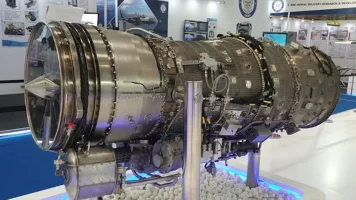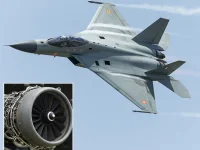- Views: 7K
- Replies: 16
India's long-standing ambition to develop a homegrown jet engine is approaching a significant milestone. The Kaveri Derivative Engine (KDE), a specialised power plant for unmanned aircraft, is scheduled to commence its final in-flight testing phase in Russia by late 2025.
Officials from the Defence Research and Development Organisation (DRDO) have indicated that the successful completion of these tests will lead to the engine's certification by 2026, a critical step for its integration into the nation's premier stealth drone, the Ghatak Unmanned Combat Aerial Vehicle (UCAV).
Developed by the DRDO’s Gas Turbine Research Establishment (GTRE), the engine will undergo 25 hours of rigorous trials on a Russian Ilyushin Il-76 flying testbed.
This final evaluation is the key to unlocking official funding for the advanced Ghatak UCAV program, which is spearheaded by the Aeronautical Development Establishment (ADE).
The development of the Ghatak, a top-priority defence project, has been strategically paced to await the formal certification of its indigenous power source, ensuring seamless integration and performance.
The journey of this engine originates from the Kaveri engine project, which began in the 1980s with the goal of powering the Tejas Light Combat Aircraft. The original program faced setbacks, including not achieving the required thrust for a fighter jet.
Learning from these challenges, the DRDO has re-engineered the engine into the Kaveri Derivative Engine. This non-afterburning version is optimised specifically for the needs of the Ghatak UCAV, delivering a thrust of approximately 50-55 kilonewtons (kN). This output is ideal for the drone's requirements of stealth, fuel efficiency, and long-endurance missions at high altitudes.
The upcoming tests in Russia represent the culmination of years of development and extensive ground trials conducted at GTRE's facilities in Bengaluru.
The Ilyushin Il-76 aircraft will serve as a high-altitude platform to assess the KDE's performance in real-world flight conditions, monitoring its stability, thrust control, and endurance.
A DRDO official stated that the engine's certification in 2026 will be a transformative achievement for India's aerospace and defence self-reliance, significantly boosting its capability as a developer of advanced jet engine technology.
The Ghatak UCAV itself represents a major leap in India's military aviation capabilities. Envisioned as a 5.5-generation stealth aircraft, it is designed with a flying-wing airframe to minimise its radar signature.
The drone will have a maximum takeoff weight of 13 tons and be capable of carrying up to 2 tons of precision-guided munitions in an internal weapons bay.
Beyond intelligence, surveillance, and reconnaissance (ISR) missions, the Ghatak is being designed with the rare capability to engage in air-to-air combat, including dogfighting.
This will allow it to perform high-risk missions and complement India's future manned fighter fleet, which includes the Advanced Medium Combat Aircraft (AMCA) and the Tejas Mk-2.





